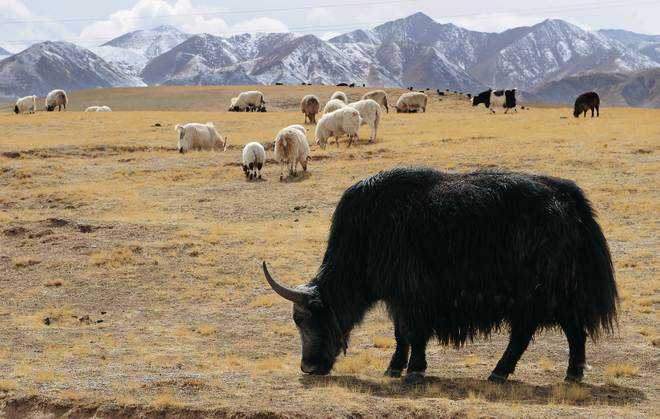Arteev Sharma
Tribune News Service
Jammu, August 24
World’s highest inhabited plateau, Ladakh, in J&K is worried over the dwindling number of its multi-utility animal — yak — as a drastic fall of nearly 60 per cent in its population has been recorded in the arid region in the past five decades.
In a wake-up call to deal with the situation effectively, the Ladakh administration has now decided to bring frozen semen from National Research Centre (NRC) on Yak in Arunachal Pradesh for cross-breeding and improving the genetic performance of the yak at the local level.
Official sources told The Tribune that the yak population had come down by more than 60 per cent since 1960. “In Ladakh, comprising Kargil and Leh districts, there has been a drastic decrease in the population. In Leh, there were around 44,000 pure yaks in 1960 but this number came down to 18,877 in 2012. It was about 13,000 in 2007,” a source said.
Similarly, Kargil district has also recorded a similar fall over the years where it is between 22,000 and 25,000 at present.
“Yak is considered as the lifeline of Ladakh because it is a multi-utility animal. Apart from the yellow-coloured milk and its products, including butter and cheese, which have a high commercial value in the market, the yak is a rich source of wool, meat and fibre. Besides, the bull yak is used for ploughing and as a load-carrier by farmers,” Dr Fida Hussain, Chief Animal Husbandry Officer (CAHO), Leh said.
“Since 1960, there has been a continuous fall in the yak population which is a worrying sign for us as we could safely say that yak is the main income source in Ladakh due to its multi-utility,” he said, adding “We are now seriously working on a yak conservation project. A team of the NRC in Arunachal Pradesh had recently visited and we too have been to the NRC for this project. We have now decided to bring yak semen from the NRC for cross-breeding and improvement of genetic performance.”
The officer said the cross-breeding would not only increase the milk production but also improve the built of an adult yak, thereby helping the local populace in using the animal for ploughing and as a load-carrier.
To a query, he said they had started to revive two yak cheese plants in Leh which were closed due to shortage of manpower and other technical issues. “We have decided to restart these plants next month,” he said.
Conservation project
The Ladakh Autonomous Hill Development Council (LAHDC), Leh, which governs Leh district politically, had been working on a mega project to produce delicious cheese made from milk of yaks for foreigners visiting the region every year. It has also decided to send a high-level team, comprising executive councillors and veterinary doctors to the Netherlands to have an indepth knowledge about the project and an interaction with experts there. Dr Mohammad Iqbal, Chief Animal Husbandry Officer, Kargil, said they had submitted a project of over Rs 5 crore to the Government of India for yak conservation. “The yak population has come down drastically over the years and it is around 25,000, including hybrid yaks in Kargil district. We have taken up the matter with the department concerned in New Delhi which has asked to route the proposal through the state government for release of funds.”
Unlock Exclusive Insights with The Tribune Premium
Take your experience further with Premium access.
Thought-provoking Opinions, Expert Analysis, In-depth Insights and other Member Only Benefits
Already a Member? Sign In Now










